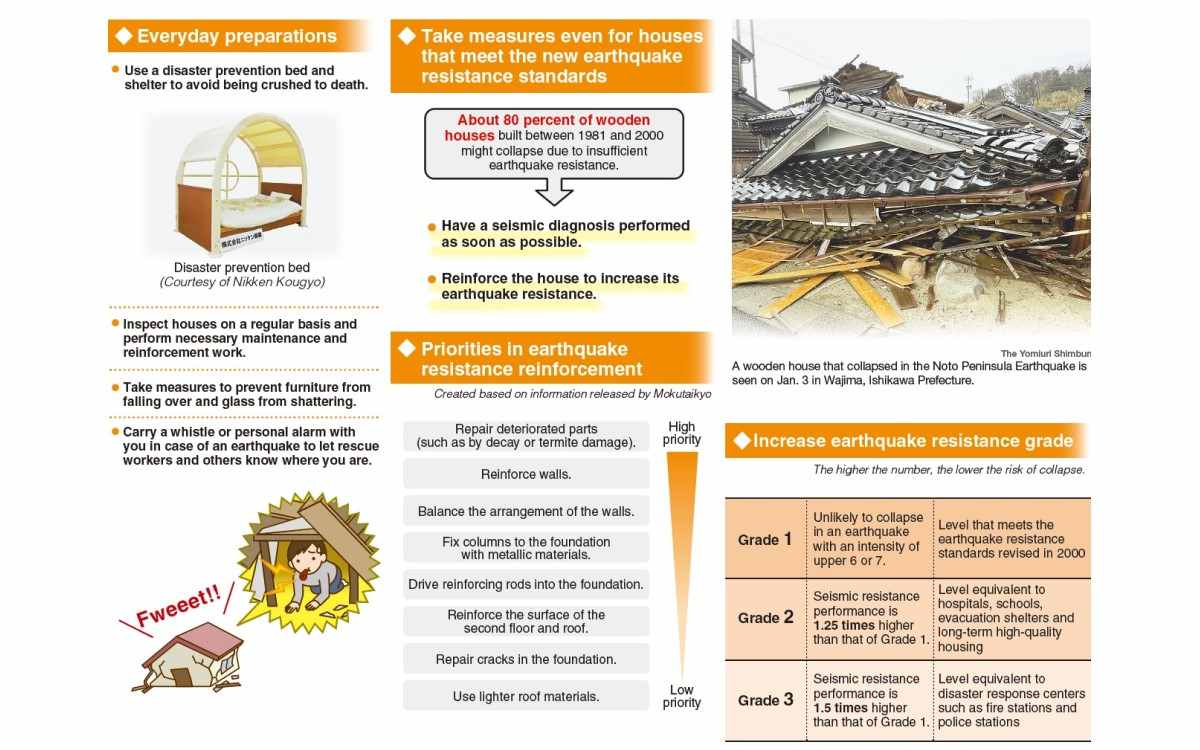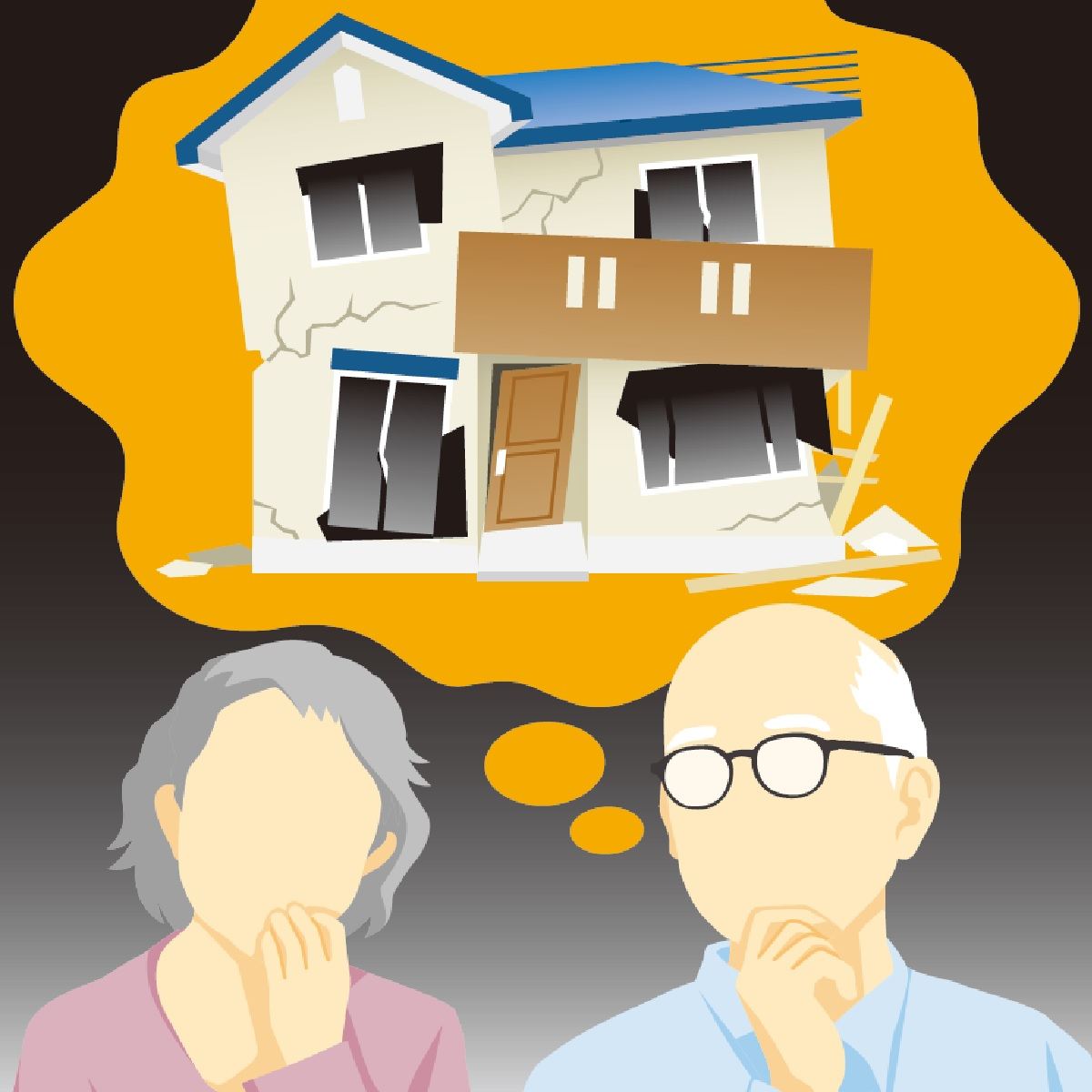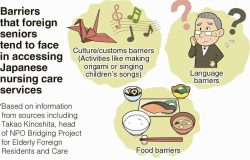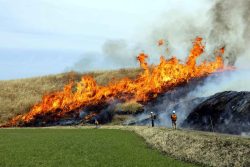Disaster Preparedness / Seismic Reinforcement of Wooden Houses an Imminent Issue; How to Prepare for Trouble

How to ready wooden houses for earthquakes
Created based on interviews with Akira Murata, Hiroshi Isoda, Reisuke Seki, Yukari Oma and others
11:50 JST, April 8, 2024
Old and worn-out wooden houses might suffer severe damage, including collapse, when a massive earthquake strikes. It is necessary to discuss plans with family members to make such houses quake-resistant, such as enhancing the seismic resistance of the house and preparing for possible collapse.
The fictitious scenario of Taro and Hanako, below on this page, illustrates issues surrounding old wooden houses.
1. A house built after 1981
Taro and his wife Hanako, both 70, live in a 40-year-old two-story wooden house built in 1984 in an increasingly depopulated area. There have been many earthquakes in the area with a seismic intensity of upper 5 or greater. Every time that their house suffered damage, such as cracks in the walls, they have repaired the damaged places and continued to live in the house.
Taro let his guard down, thinking, “The house will be strong enough because it was built after 1981 and meets the new earthquake resistance standards.”
When a powerful earthquake occurred on a winter morning, Taro and Hanako were in the living room on the first floor. “Get out of the house!” he shouted, and they went outside. The earthquake continued for several minutes. Then, part of the roof collapsed, the house tilted and the walls were destroyed.
2. Shocked by damage to the house
The earthquake registered an intensity of upper 6 on the Japanese seismic scale. Many houses suffered severe damage and the first floor of a nearby old wooden house was crushed. A man Taro knows whose house was completely destroyed said: “Our house was just renovated. I don’t understand why it happened.”
On the other hand, Taro’s eldest son Ichiro, 35, who lives in a condominium in Tokyo, has been worried about the condition of the old house and frequent occurrence of earthquakes in the area where his parents live. He was relieved to know that his parents were safe but was shocked by the damage to their house. “The structure of the house might have been weakened by the recent series of earthquakes. I should have talked with them about increasing the seismic resistance of the house,” Ichiro thought.
3. ‘Should we move to a new place?’
Taro’s house was assessed as “dangerous” in an emergency risk assessment conducted by the municipal government after the earthquake. Living in a shelter caused them a high amount of stress. Since Hanako wanted to live in their house again, the couple decided to return.
Afterwards, the house was declared “half-destroyed on a large scale” by the earthquake in a damage survey conducted by the municipal government. To live safely in the house, it became necessary to significantly improve the house’s earthquake resistance. Meanwhile, Ichiro asked his parents to live with him in Tokyo. Hanako said: “Our house might collapse in the aftershocks. We should take him up on his offer.” Taro was of two minds, unsure if they should reconstruct their house or move to Tokyo and live with Ichiro’s family.

Quake resistance varies
To evaluate the safety of houses, earthquake resistance standards should be checked. In 1981, the national government revised the old standards and introduced new ones, requiring houses to be strong enough to withstand earthquakes with a seismic intensity of upper 6 or 7. The new standards were further toughened in 2000, following the 1995 Great Hanshin Earthquake.
In January’s Noto Peninsula Earthquake, which registered a maximum seismic intensity of 7, over 68,000 houses were damaged in Ishikawa Prefecture and the first floors of many old wooden houses were crushed. Many of the victims were listed by the Ishikawa prefectural government as having died due to building collapses.
Akira Murata, an assistant professor at Kanazawa University’s Earthquake Engineering Lab., studied about 100 wooden houses in the Shoin district of Suzu in the prefecture, where the earthquake registered an intensity of upper 6, and found that about 40 of them were completely destroyed. According to the study, many houses that are believed to have been built or refurbished between 1981 and 2000 suffered severe damage. Earthquakes with a maximum intensity of upper 6 struck the Noto region in 2007 and 2023. “In addition to the age of houses, many were further weakened by a series of earthquakes and then heavily shaken by the Jan. 1 earthquake. This might have had significant impact,” Murata said.
Mokutaikyo, an association of businesses that perform seismic reinforcement work on wooden houses, conducted seismic diagnosis surveys and found that about 86% of wooden houses built between 1981 and 2000 do not have sufficient seismic resistance and could collapse if a powerful earthquake occurs. This is because the standards used in that period were less strict than those implemented in 2000 and beyond. Such houses might also have degraded due to their age.
Hiroshi Isoda, a professor at the Research Institute for Sustainable Humanosphere, Kyoto University, who studies earthquake-resistant structures, said, “Seismic diagnosis should check the deterioration of a structure so that necessary quake resistance reinforcement can be conducted.”
Earthquake resistance reinforcement work for wooden houses includes reinforcing load-bearing walls and joints between the columns and foundation, as well as using lighter roofing materials. This work should be performed with consideration for budget and other priorities. In areas where depopulation and population aging are increasing concerns, many houses are not strong enough to withstand strong earthquakes. “I recommend people discuss necessary measures with family members when they gather together, such as during homecoming visits,” said Reisuke Seki, the secretary general of Mokutaikyo.
Increase seismic resistance grades
Yukari Oma, a first-class registered architect, said, “People should increase the earthquake resistance grade of their houses when they build or renovate them.” The grades are based on the housing performance indication system that is designed to evaluate the structure’s stability and other factors in order to mitigate damage from earthquakes. Houses that meet the new earthquake resistance standards and have a higher grade can withstand stronger earthquakes. The earthquake resistance performance of a Grade 3 building is 1.5 times higher than that of a Grade 1 building.
It is also essential to prepare for earthquakes and learn what to do in the event of an earthquake. People should consider using so-called “disaster prevention” beds and other preparation tools. According to the Tokyo-based manufacturer Nikken Kougyo Co., the frames of the company’s beds are made of steel and are capable of withstanding a weight of 10 tons from above. If you feel a strong tremor in a house, you should get out of the house quickly while watching out for kawara roof tiles and other objects falling from above.
***
Most people have low sense of disaster risk in ordinary times

Prof. Kusunoki inspects a collapsed building in Wajima, Ishikawa Prefecture, in this photo taken on Jan 6.
On the day we ushered in the new year, a massive 7.6 magnitude earthquake struck the Noto region of Ishikawa Prefecture. More than 240 people have been confirmed dead. Some people living outside of the prefecture were also reportedly caught in the disaster during their trips home to spend time with family for the New Year’s holidays.
Disasters can occur in any place at any time. As a reporter on disaster prevention, I have been covering natural disasters for some time, but I felt as if I had been slapped by the cruelty of reality once again.
Starting Jan. 5, I spent several days covering the disaster-hit area while accompanying Prof. Koichi Kusunoki of the University of Tokyo’s Earthquake Research Institute, a scholar on seismic engineering, as he investigated building damage.
In the center of Wajima, Ishikawa Prefecture, near the famous Asaichi-dori morning market tourism spot, which was destroyed by fire, a reinforced concrete building had toppled on its side, crushing the store-cum-house next to it.
Rows of tasteful tile-roofed wooden houses also collapsed, and the deserted town showed the severity of the damage wrought.
In the latest survey, besides collapsed buildings, there were also concrete buildings leaning over due to damage to their foundations. If such buildings were to continue to be used, people living there may develop health problems such as dizziness and nausea.
“Even with today’s advanced disaster prevention and mitigation technology, it is important for everyone to be aware of the likelihood that damage beyond expectations can sometimes occur,” said Kusunoki.
The words of the researcher, who has studied disaster-stricken areas in Japan and abroad for about 30 years, including by conducting on-site investigations of the Turkey-Syria earthquake that killed over 60,000 people, hit home with force.
The reality is, however, that such a sense of urgency has not adequately grown among people.
According to a survey conducted last year by the Japanese Red Cross Society, a total of 55% of respondents answered that they think “they may encounter a natural disaster in the near future” less than once every six months.
However, one out of four respondents said they haven’t taken any disaster prevention measures at all. These findings show the difficulty of perceiving their own disaster risk.
“We must never forget the fact that many lives have been lost. At the same time, we must continue to think about what we can do for the future,” Kusunoki said. When, what, how and to whom information should be spread is important to consider. We journalists are also being asked these questions.
"JN Specialities" POPULAR ARTICLE
-

The Japan News / Weekly Edition (12/12-12/18)
-

Noodle Dining Shunsai / Rich Oyster Ramen to Savor at Odasaga; Experienced 68-year-old Owner Creates Numerous Ramen Varieties
-

The Japan News / Weekly Edition (12/5-12/11)
-

People Keep Loved Ones’ Ashes Close in Special Jewelry, Small Urns as Unique Way to Memorialize Them
-

The Japan News / Weekly Edition (12/19-12/25)
JN ACCESS RANKING
-

Tokyo Economic Security Forum to Hold Inaugural Meeting Amid Tense Global Environment
-

Keidanren Chairman Yoshinobu Tsutsui Visits Kashiwazaki-Kariwa Nuclear Power Plant; Inspects New Emergency Safety System
-

Imports of Rare Earths from China Facing Delays, May Be Caused by Deterioration of Japan-China Relations
-

University of Tokyo Professor Discusses Japanese Economic Security in Interview Ahead of Forum
-

Japan Pulls out of Vietnam Nuclear Project, Complicating Hanoi’s Power Plans

























